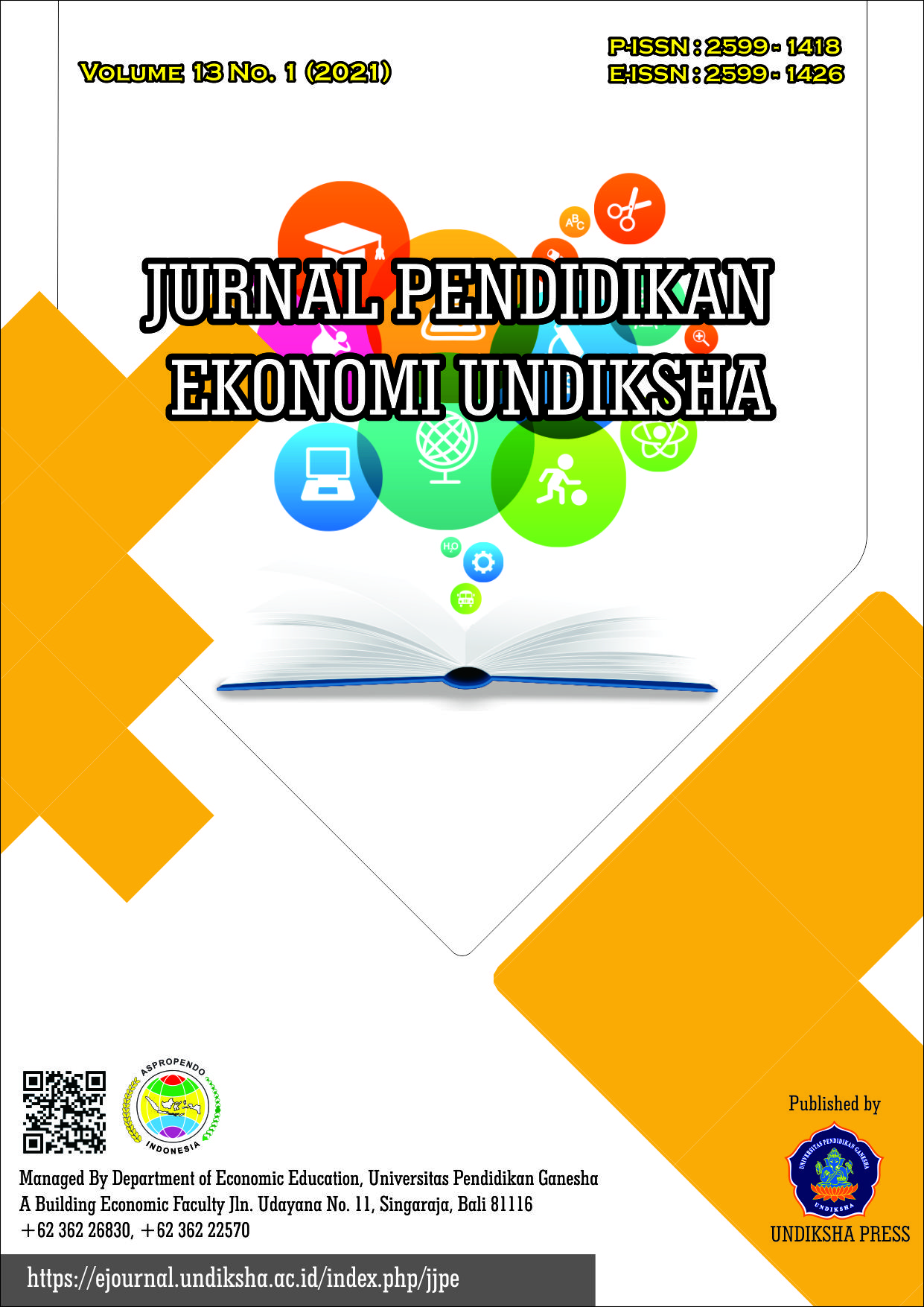Pengaruh Elektrifikasi Terhadap Produk Domestik Regional Bruto Per Kapita: Studi Empiris Tahun 2014 – 2019
DOI:
https://doi.org/10.23887/jjpe.v13i1.33833Keywords:
electrification ratio, benefit of electricity, district/city, energy rights, productivityAbstract
This study aims the effect of electrification on productivity. We used data panel on kabupaten dan kota level with 2014-2019 period. The method in this research is descriptive quantitative with the data used is secondary data in the form of GDRB panel data throughout Indonesia In this study, productivity defined as GDRB per capita. Estimation result shows that the electrification ratio has a positive and significant effect to GDRP per capita on 2014-2019 nationally, in Sumatera island, and Kalimantan island. The presence of electrification can support productivity, such as lightning, use of mahines more efficiently, home appliance, and ICT or communication. Therefore, electrification should be fulfilled in Indonesia to increase GDRP per capita growth.References
Akpandjar, G., & Kitchens, C. (2017). From Darkness to Light: The effect of electrification in Ghana, 2000 – 2010.
Alam, M. (2018). The Nexus Between Access to Electricity and Labour Productivity in Developing Countries. Energy Policy, 122, 715–726.
Alexopoulos, Michelle, Cohen, & Jon. (2019). Will the New Technologies Turn the Page on U.S. Productivity Growth. Economics Letters, 175, 19–23.
Arif, M. (2014). Pengaruh Pendidikan Terhadap Pendapatan Domestik Regional Bruto di Indonesia. Signifikan, 3(1).
Armey, L. E., & Hosman, L. (2015). The Centrality of Electricity to ICT Use in Low-Income Countries. Telecommunications Policy.
Barnes, & Binswanger. (1986). Impact of Rural Electrification and Infrastructure on Agricultural Changes, 1966-1980. Economic and Political, 21(1).
Battisti, M., Belloc, F., & Del Gatto, M. (2019). Labor Productivity and Firm-level TFP with Technology-specific Production Functions. Review of Economic Dynamics, 35, 283–300.
Best, R., & Burke, P. J. (2018). Electricity Availability: A Precondition for Faster Economic Growth? Energy Economics, 74, 321–329.
Briones, R., & Felipe, J. (2013). Agriculture and structural transformation in developing Asia: Review and outlook. ADB Economics Working Paper Series, 363(363), 1–39.
Burke, P. J., & Kurniawati, S. (2018). Electricity Subsidy Reform in Indonesia: Demand-side Effects on Electricity Use. Energy Policy, 116, 410 – 421.
Cahyo. (2020). Structural Transformation of Agriculture and Poverty in Indonesia. Wiga: Jurnal Penelitian Ilmu Ekonomi, 10(1).
Chen. (2007). The Relationship Between GDP and Electricity Consuption in 10 Asian Countries. Energy Policy, 35, 2611–2621.
Cleveland, C. J., Costanza, R., Hall, C. A., & Kaufmann, R. (1997). Energy and the US Economy: a Biophysical Perspective. Int. Libr. Crit. Writ. Econ., 75, 295–302.
Costa-compi. (2018). The Economic Impacts of Electricity Losses. Energy Economics, 75, 309–322.
Cronenberg. (2012). How do the Benefits from Active Demand Vary? A Comparison of Four EU Countries. Energy Conference and Exhibition (ENERGYCON), 693–700.
Dinkelman, T. (2011). The Effects of Rural Electrification on Employment: New Evidence from South Africa. American Economic Review, 101, 3078–3108.
Doms, M. E., Jarmin, R. S., & Klimek, S. D. (2004). Information technology investment and firm performance in US retail trade. Economics of Innovation and New Technology, 13(7), 595–613.
Jajri, I., & Ismail, R. (2010). Impact of Labour Quality on Labour Productivity and Economic Growth. Africa Journal of Business Management Vl, 4(4), 486 – 495.
Jorgenson, D. . (1984). The role of energy in productivity growth. Energy J, 5(3), 11–26.
Kanagawa, M., & Nakata, T. (2008). Assessment of Access to Electricity and the Socio – Economic Impacts in Rural Areas of Developing Countries. Energy Policy, 36, 2016 – 2029.
Kassem, D. (2018). Does Electrification Cause Industrial Development? Grid Expansion and Firm Turnover in Indonesia (No. 052; CRC TR 224).
Khandker. (2013). Welfare Impacts of Rural Electrification: A Panel Data Analysis from Vietnam 659-692. Economic Development and Cultural Change, 61(3), 659–692.
Kroll, H., Horvat, D., & Jäger, A. (2018). Effects of automatisation and digitalisation on manufacturing companies’ production efficiency and innovation performance. Fraunhofer ISI Discussion Papers - Innovation Systems and Policy Analysis, 58.
Kurt, S., & Kurt, U. (2015). Innovation and Labour Productivity in Brics Countries: Panel Causality and Co-integration. Procedia: Social and Behavioral Sciences, 195, 1295 – 1302.
Kyriakarakos, G., Balafoutis, A. T., & Bochtis, D. (2020). Proposing a paradigm shift in rural electrification investments in Sub-Saharan Africa through Agriculture. Sustainability (Switzerland), 12(8). https://doi.org/10.3390/SU12083096
Lagenjik, A. (2008). Survival Guide For Scientists. Amsterdam: Amsterdam University Press.
Leviakangas, P., Paik, S. M., & Moon, S. (2017). Keeping up with the pace of digitization: the case of the Australian construction industry. Technology in Society, 50, 33–43.
Lewis, J., & Severnini, E. (2017). Short and Long Run Impacts of Rural Electrification: Evidence from the Historical Rollout of the U.S. Power Grid.
Lipscomb. (2013). Development Effects of Electrification: Evidence from the Topographic Placement of Hydropower Plant in Brazil. American Economic Journal: Applied Economics, 5(2), 200–231.
Marrocu, E., & Paci, R. (2012). Education or Creativity: What Matters Most for Economic Performance ? Economic Geography.
Mcguckin. (1998). The Effect of Technology Use On Productivity Growth. Economics of Innovation and New Technology, 7(1), 1–26.
Schurr, S. . (1982). Energy Efficiency and Productive Efficiency: Some Thoughts Based on American Experience. Energy J, 3–14.
Sebastian. (2020). Electricity Access and Structural Transformation Evidence from Brazil’s Electrification (Policy Research Working Paper).
Shaw. (2009). The Value of Reducing Distribution Losses by Domestic Load-Shifting: a Network Perspective. Energy Policy, 37(8), 3159–3167.
Stern, D. I., & Cleveland, C. . (2004). Energy and Economic Growth (No. 0410).
Suryadi. (2001). Kontribusi Total Produktivitas terhadap Perekonomian DKI Jakarta, Infomet. Cestar Bekerja Sama Dengan BPS, 1(2).
Suryani, E. (2006). Analisis Total Faktor Produktivitas dan Pertumbuhan Ekonomi Sumatera Selatan. Jurnal Ekonomi Pembangunan, 4(2), 93–105.





